This Month’s Puzzler
My company is trying to decide whether to sell or expand a facility it purchased. Unfortunately, we inherited a mess from the previous owners. There are no equipment files, and many equipment nameplates are missing or are only partially legible. Some pumps and blowers were made by vendors that have been taken over by other manufacturers; they can’t find the files for such legacy products. Much of the equipment was purchased used. Some equipment was imported from Korea, Japan and Germany. No drawings exist at all. We brought in an engineering firm for the first two months but it over-ran its budget; we fired the firm for lack of progress.
What can we do? How can we determine equipment capacities and create data sheets for equipment like pumps, blowers and instruments? I don’t even have an equipment list.
An Essential Question
The company must ask itself: Does the acquired business add value to the overall company in the short and long term even if getting all the missing information requires considerable financial expense and manpower effort? If that seems to be the case, then go ahead and spend the money. However, an engineering firm over-running its budget suggests the company has additional problems. The choices are very simple. Does the company see value and return for the effort? If it’s reluctant to spend the money to create the files, which the question asked implies, and the business doesn’t fit its long-term business plan, then the answer is obvious. The company doesn’t need outside validation for the decision it already has made.
The unfortunate consequence of selling or shutting down the site is that the company will have to remediate the site to ensure it meets local environmental regulations. In addition, in the event of a shutdown, it will have to get a competent salvage firm to sell the equipment. Because the company doesn’t have much information about the equipment, my conjecture is that the facility was bought on the cheap and, most likely, the company might not even get a nickel on every dollar it spent. All said and done, it’s not a pretty situation. The company has to justify its business decisions.
Girish Malhotra, president
EPCOT International, Pepper Pike, Ohio
Be Diplomatic
It appears “due diligence” either was hastily done or not done at all. Whether you decide to sell or expand the facility, you will need to do a due diligence. Consider the following issues:
1. You need to approach the issue strategically. Get your management’s buy-in that you need to perform a due diligence of the plant site and equipment — as soon as possible. Management folks may have good financial acumen but might not understand process or environmental risks. If so, you must train them. Be assertive as well as diplomatic. Show them, with quantitative examples, that lack of information about equipment such as turbines, boilers and furnaces could cause accidents and, consequently, considerable financial loss as well as erosion of public trust and company prestige.
2. Prioritize the items that require more information. If equipment is in disrepair, damaged or corroded, get rid of it.
3. Don’t forget environmental due diligence — soil sample analyses, wastewater treatment, air emissions and fence-line (air) analyses.
4. Long term, consider organizing training in the basics of process safety and environmental risk assessment for your management team — not nitty-gritty details, just basics. In the future, you want to avoid a repeat of this episode.
GC Shah, senior consultant
Wood, Houston
Work The Problem
Equipment without nameplates at least can be partially identified. After that, you’re stuck with field tests. Unfortunately, you can’t do field tests without some drawings. Start with a block flow diagram (BFD) and a simple material balance table (below the BFD). For hydraulic tests, stick to hand sketches of isometrics.
You will need a 35-ft tape measure, a folding measuring stick, a 250-ft tape, a Vernier caliper, a clinometer, a 1-in. slip-on flange, duct tape, a voltmeter, a clamp-on amp probe, a weigh scale, 10-ml and 50-ml graduated cylinders, a 250-ml beaker, Zahn cup viscometers, and a camera with a telephoto lens and autofocus.
Instead of hiring an engineering firm, try hiring a couple of engineers with substantial plant experience. Their discipline doesn’t really matter: as your career progresses, you learn how to survey pipelines, lay out equipment and even set up motor buckets and take apart pumps. Use these engineers to develop drawings and the equipment list you will need to decide the fate of the plant.
Let’s start with pump identification. Most pump vendors use a distinct color. (We used to laugh about how you could know who worked on an oil well from the paint scrapings around the casement.) Start with that. Sometimes a Google search of images of pumps can help identify a particular pump. The vendor’s local representative then can assist you in determining the model. A tape measure and flange stamps will help you identify the size of the suction and discharge of the pump. The speed of the motor also eliminates some pump curves in a vendor catalog. If you have Japanese or German pumps, you generally will get good cooperation from their manufacturers. My experience with Korean vendors is generally poor; you may be stuck with performance tests.
A pump performance test involves a measurement of current draw and flow rate or pressure. Although it might be nice to have an impeller size, it’s more important to know what the pump will do than its operating size. The idea is to create a functional hydraulic model with a simulator, then measure the motor current draw. You can determine the flow from a plant flow meter or estimate it from filling or emptying a tank. With that in hand, and the knowledge of the motor speed, it’s possible to narrow down the right pump curve from a vendor catalog. Even if this isn’t possible, you can estimate the pump hydraulic efficiency from the difference between the power required based on the simulation and the power delivered to the pump based on motor efficiency. I use an old utility equation: lowest expected motor efficiency = 83.594 + 2.284×Ln(hp).
Suppose you’re unable to identify the motor size or speed because you can’t decipher the motor tag. Motor dimensions are standardized. There are detailed mechanical drawings. Take measurements of the motor; some of these will require the Vernier caliper. From these dimensions, you can determine the frame size from the drawings.
The hydraulic model will require isometric drawings. Here’s where the clinometer and measuring tapes and sticks come in handy. Use the clinometer to estimate the height of elevations like risers. Clinometers usually are good to ±6 in., which is good enough for hydraulics.
You won’t get very far with the hydraulic analysis without physical data. That’s where the viscometers and weigh scale come in. Take several samples of the liquid to be pumped and measure them.
One of the real challenges with hydraulic analysis are the equipment pressure drops: with turbulent flow the drops can be roughed from one data point: ΔP2/ΔP1 = (Q2/Q1)2 where ΔP is pressure drop, Q is gas or liquid flow rate, and 1 stands for upstream and 2 downstream. Laminar flow is doable but more complicated. Do a complete balance around the process using dropping or rising levels in tanks if no flow measurements are available. Put these into the hydraulic model and solve by trial and error.
Developing data sheets with large equipment like dryers and heat exchangers usually is much easier than for pumps. If nothing is available, simulation software can provide data sheets for heat exchangers, for example.
Once this information is collected, it should be possible to develop a material and energy balance for the plant. This is the preliminary step necessary to evaluate where your company goes from there.
Dirk Willard, consultant
Burley, Idaho
February’s Puzzler
Our client is having trouble with a C3/C4 (propane/butane) splitter in a fluid catalytic cracker. I’d like to impress the client by solving its problems but am confused by the information collected during the kick-off walkdown.
The splitter tower has a tight i-C4 limit. The real problem is C3 impurities in the bottoms. A third of the trays in the upper tower were replaced a year ago by a bed of 1-in. packing to improve C3 recovery from the bottoms. However, recovery didn’t improve. A distribution plate instead of spray nozzles distributed the liquid over the packing; the reasoning was that this would avoid the nozzles’ turndown limitations and their risk of fouling. The plant then introduced spray nozzles anyway — with no effect on recovery.
The operators are fairly new because of cutbacks in staff. They tell me that to their knowledge the tower has always performed like this. One older foreman says performance was better before the packing replaced the trays but the trays were old, corroded and leaking. Corporate engineering installed pressure transmitters across the packing a few months after the packing was installed. The pressure drop was higher than expected, so the 1-in. packing was replaced by 2-in. packing. However, this didn’t improve tower performance. Unfortunately, the upper and lower pressure transmitters weren’t trended because of limited distributed-control-system memory. Corporate engineering modeled the beds and can find nothing wrong with its decision to replace the trays.
How should we approach this problem?
Send us your comments, suggestions or solutions for this question by January 12, 2018. We’ll include as many of them as possible in the February 2018 issue and all on ChemicalProcessing.com. Send visuals — a sketch is fine. E-mail us at [email protected] or mail to Process Puzzler, Chemical Processing, 1501 E. Woodfield Rd., Suite 400N, Schaumburg, IL 60173. Fax: (630) 467-1120. Please include your name, title, location and company affiliation in the response.
And, of course, if you have a process problem you’d like to pose to our readers, send it along and we’ll be pleased to consider it for publication.

